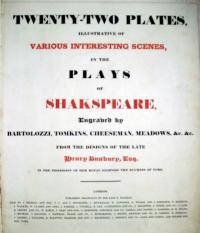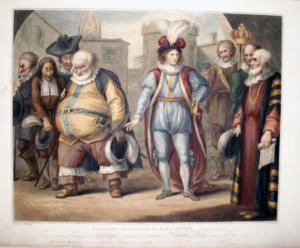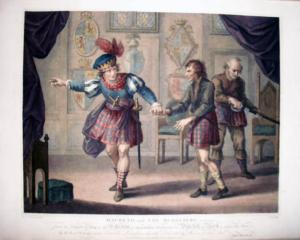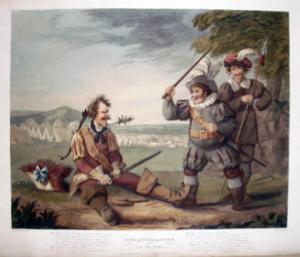Around the end of the eighteenth century, the most successful London print shop was the Shakespeare Gallery, run by John Boydell. Their most famous project was a series of over one hundred extravagantly large engravings illustrating well-known scenes from Shakespeare’s plays. Boydell’s success led to many imitations, such as the Woodmason’s Shakespeare Gallery and the Irish Shakespeare Gallery. The most ambitious was the Poet’s Gallery, managed by Thomas Macklin.
Macklin hired the popular caricaturist Henry Bunbury to create a similar series of pen and ink and watercolor drawings to illustrate Shakespeare’s plays. Bunbury chose comic, often obscure scenes, emphasizing the outlandish and the ridiculous. His designs were engraved over five year by Francesco Bartolozzi (1727-1815), Peltro William Tomkins (1760-1840), Thomas Cheeseman (active 1780-1790), and Robert Mitchell Meadows (died 1812). The artists only finished twenty-two prints, which in the end was no real competition for Boydell.
See also Andrew White Tuer (1838-1900), Bartolozzi and his works: a biographical and descriptive account of the life and career of Francesco Bartolozzi, R.A. (illustrated): with some observations on the present demand for and value of his prints …: together with a list of upwards of 2,000 … of the great engraver’s works (London: Field & Tuer; New York: Scribner & Welford, [1882]) Graphic Arts Collection (GA) Oversize Rowlandson 953.2q




i have a folio of the shakspere gallery collection of forty five steel engravings by J.S. Virtue & co. after pictures of eminent artists such as RA Artlett,
E Stodart,A Hughs,CW Cope,W Q Orchardson & so on . I am wondering if anyone could give me an idea of how old this collection would be & a rough value of it.